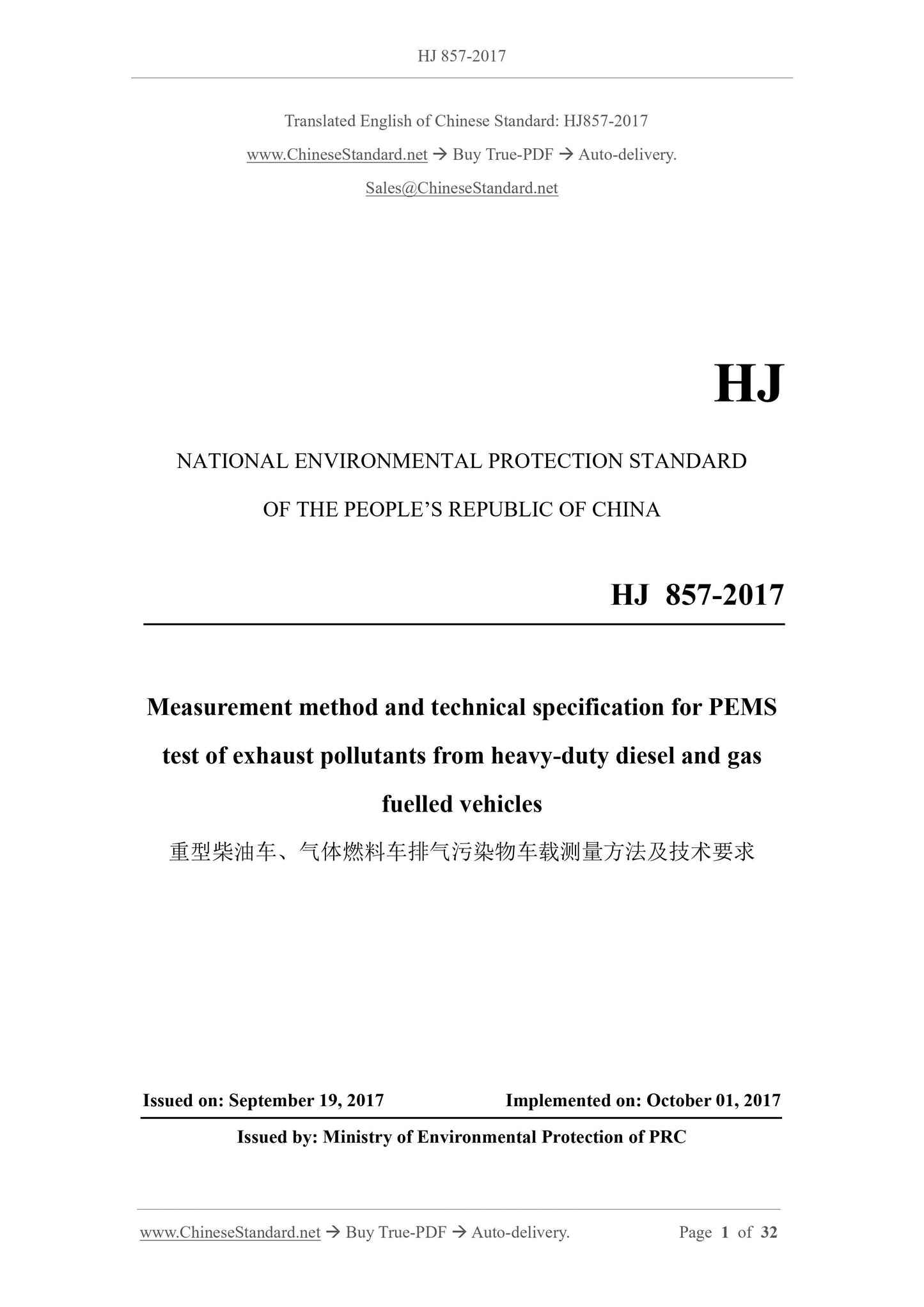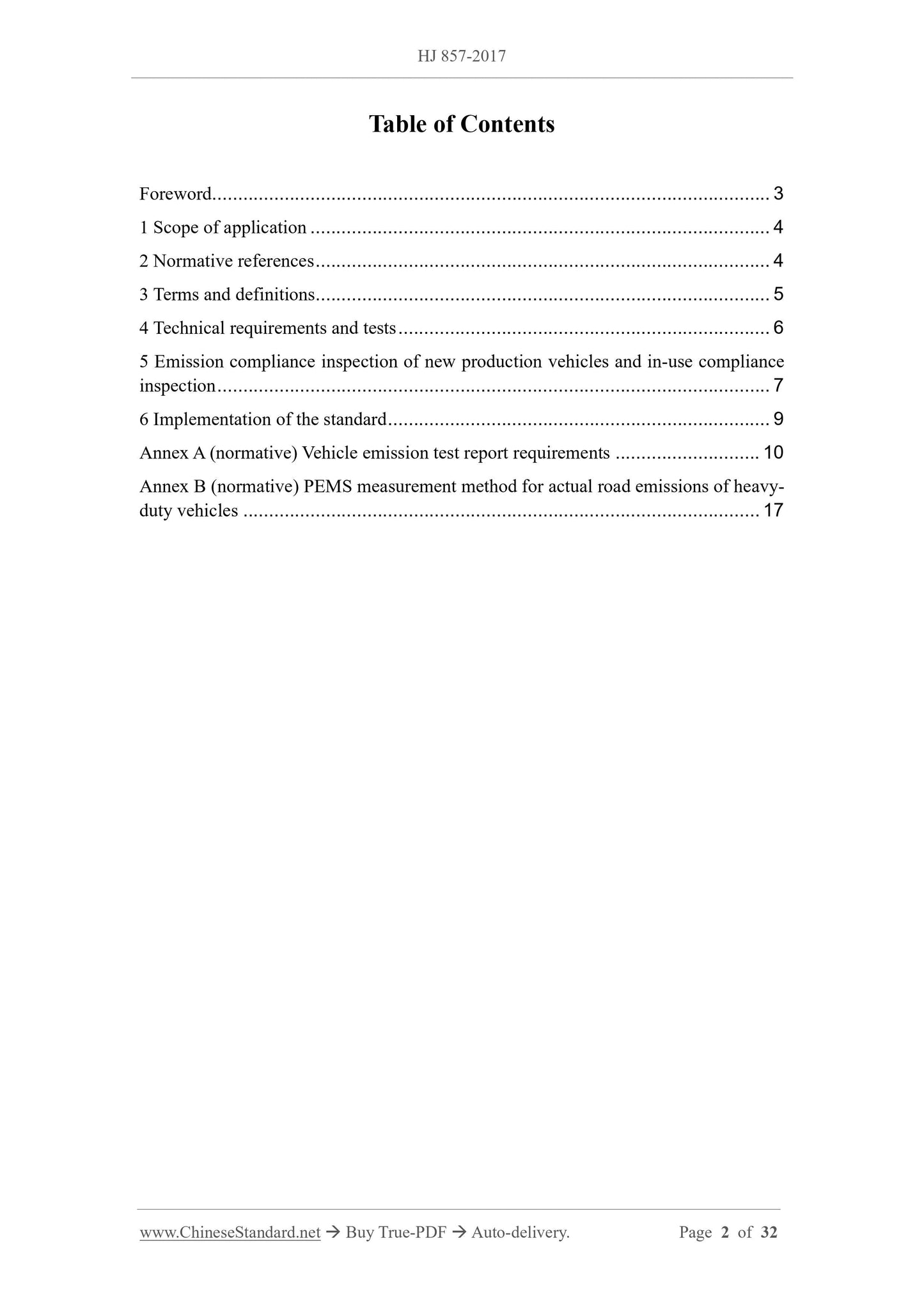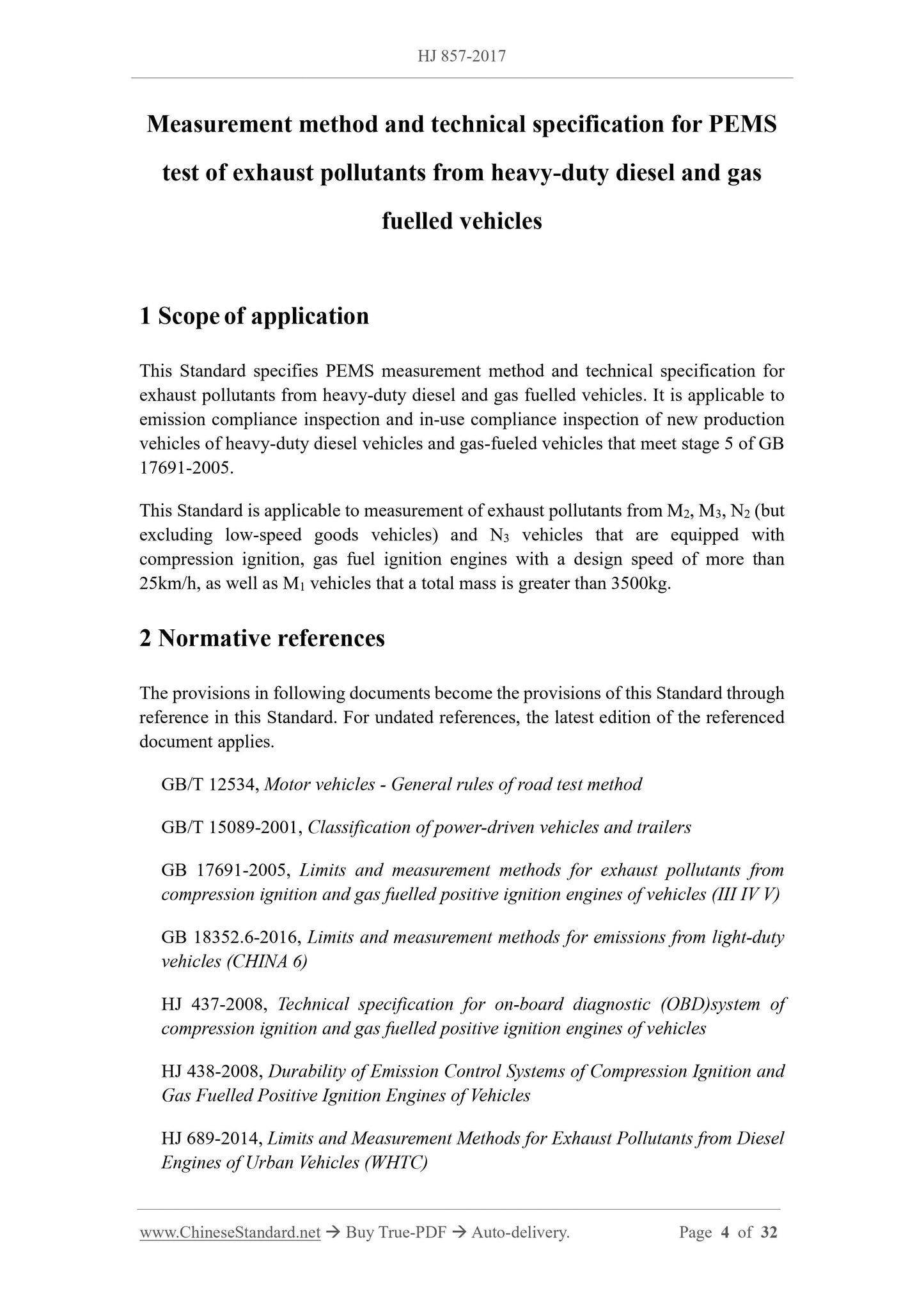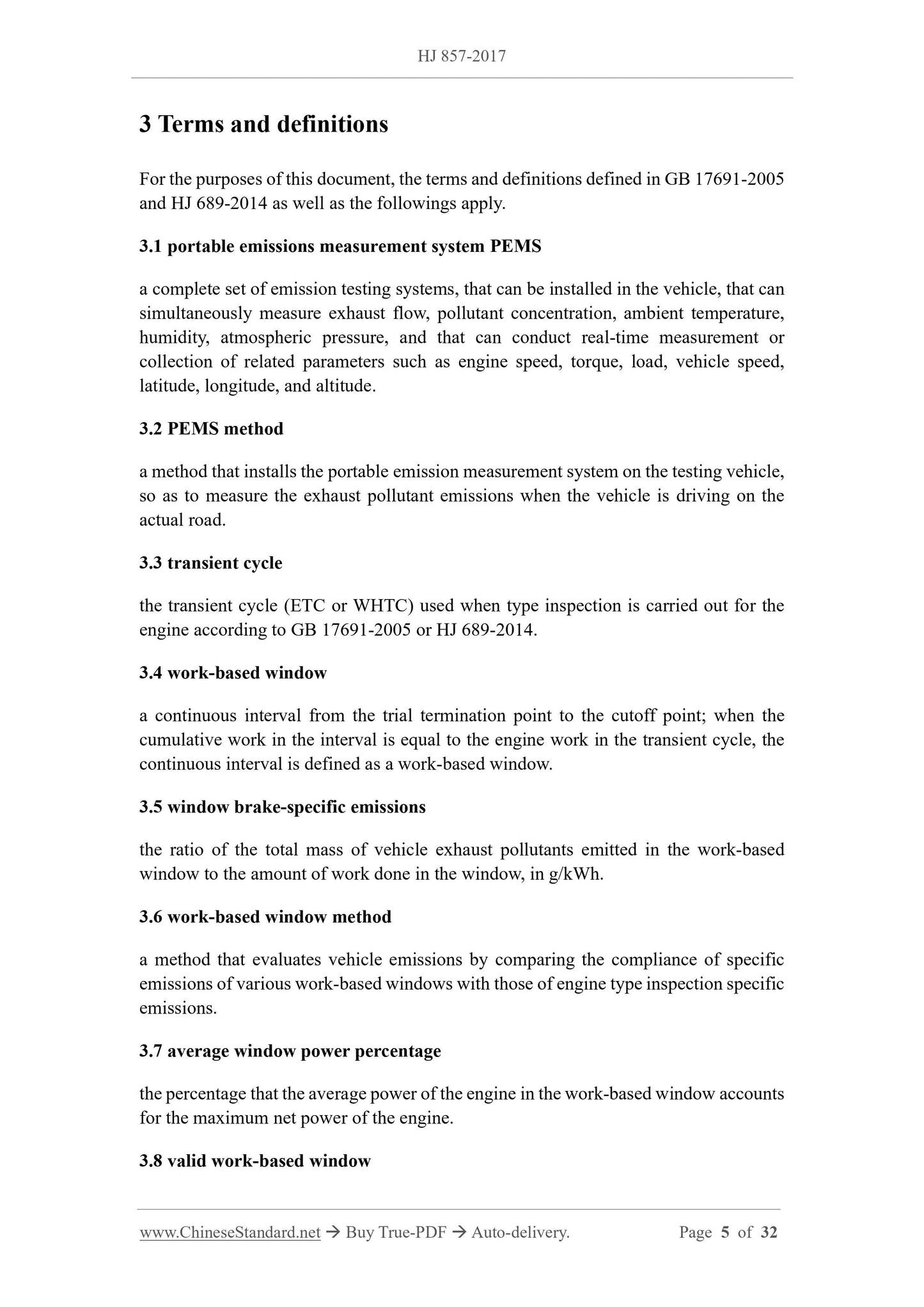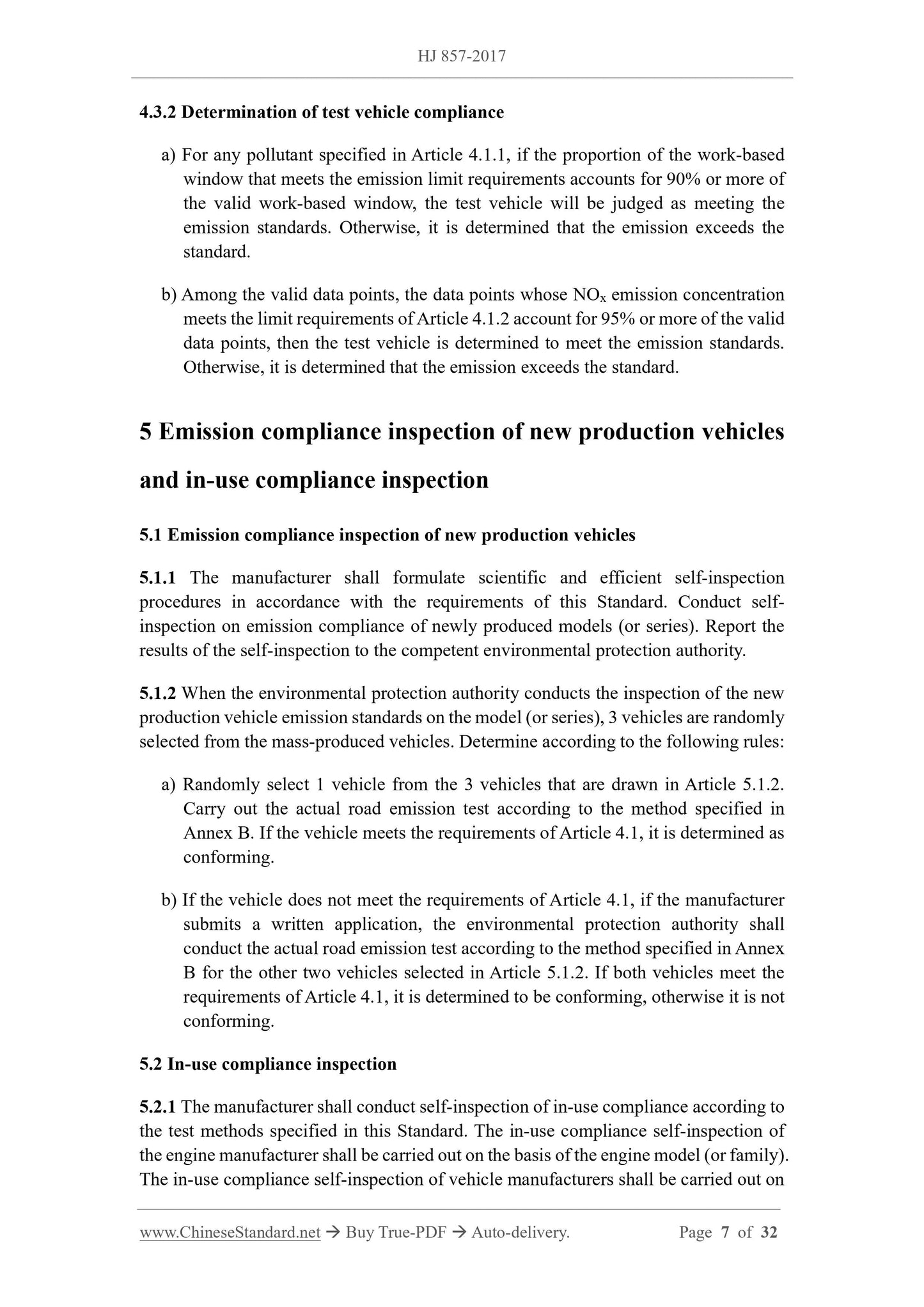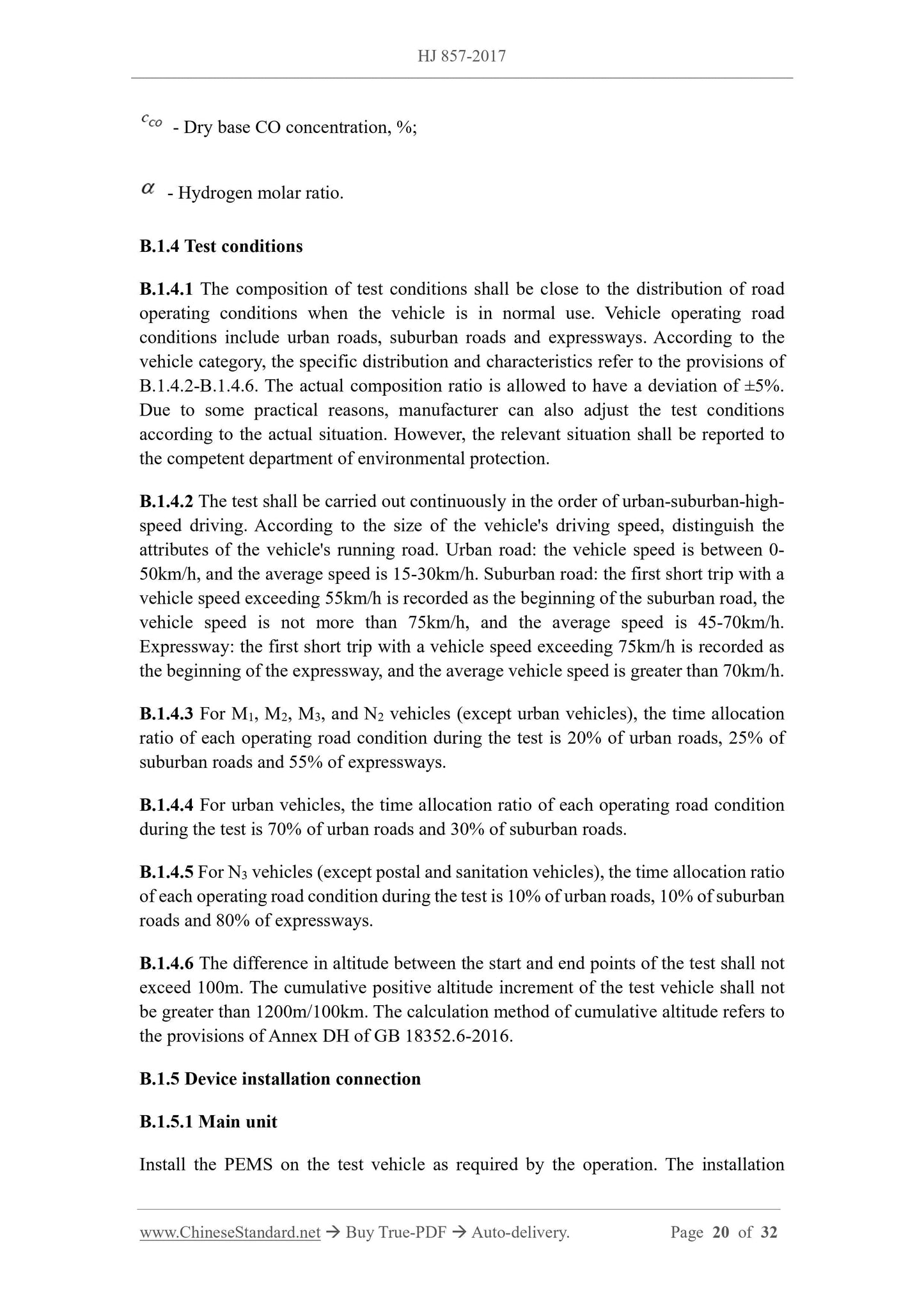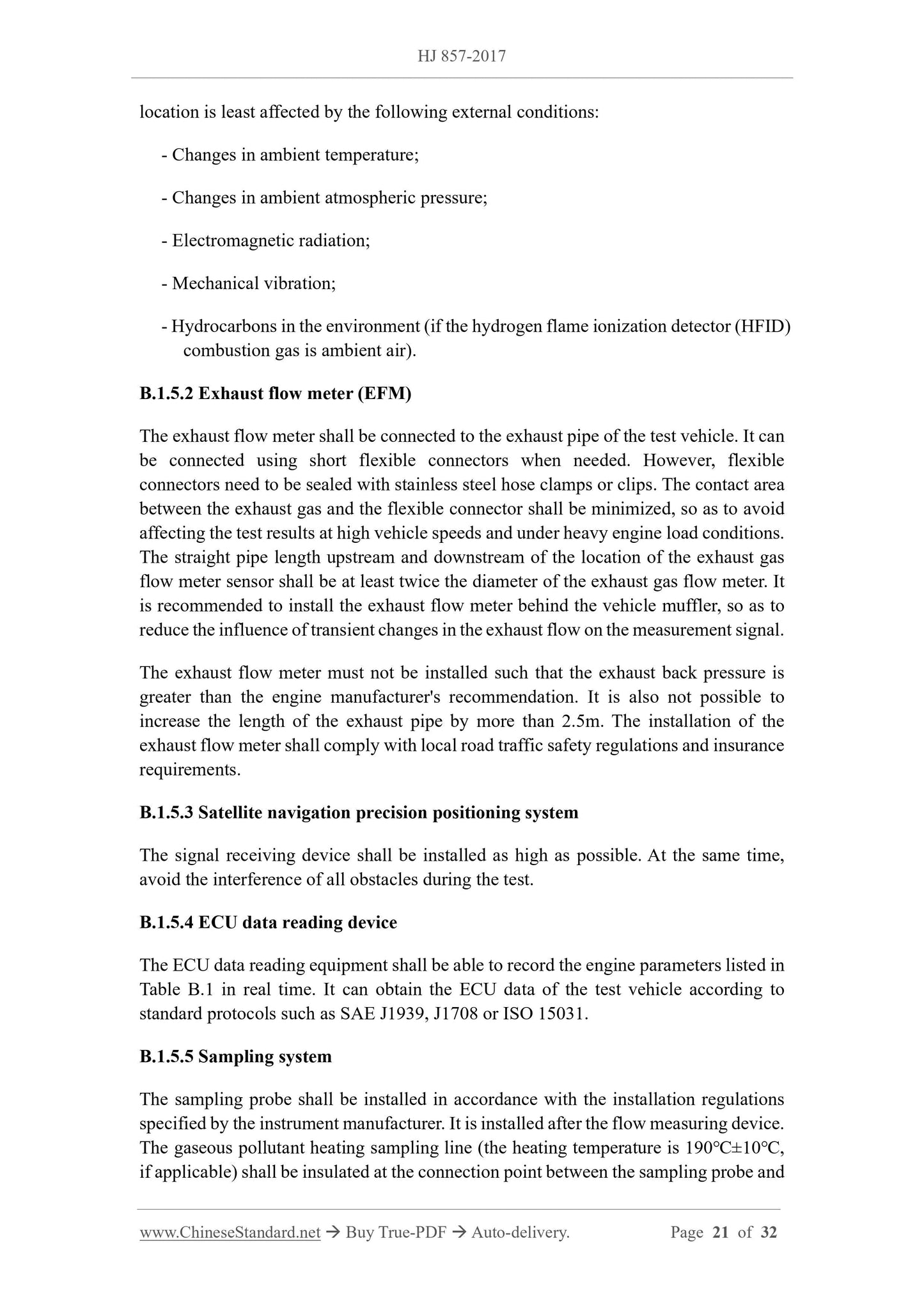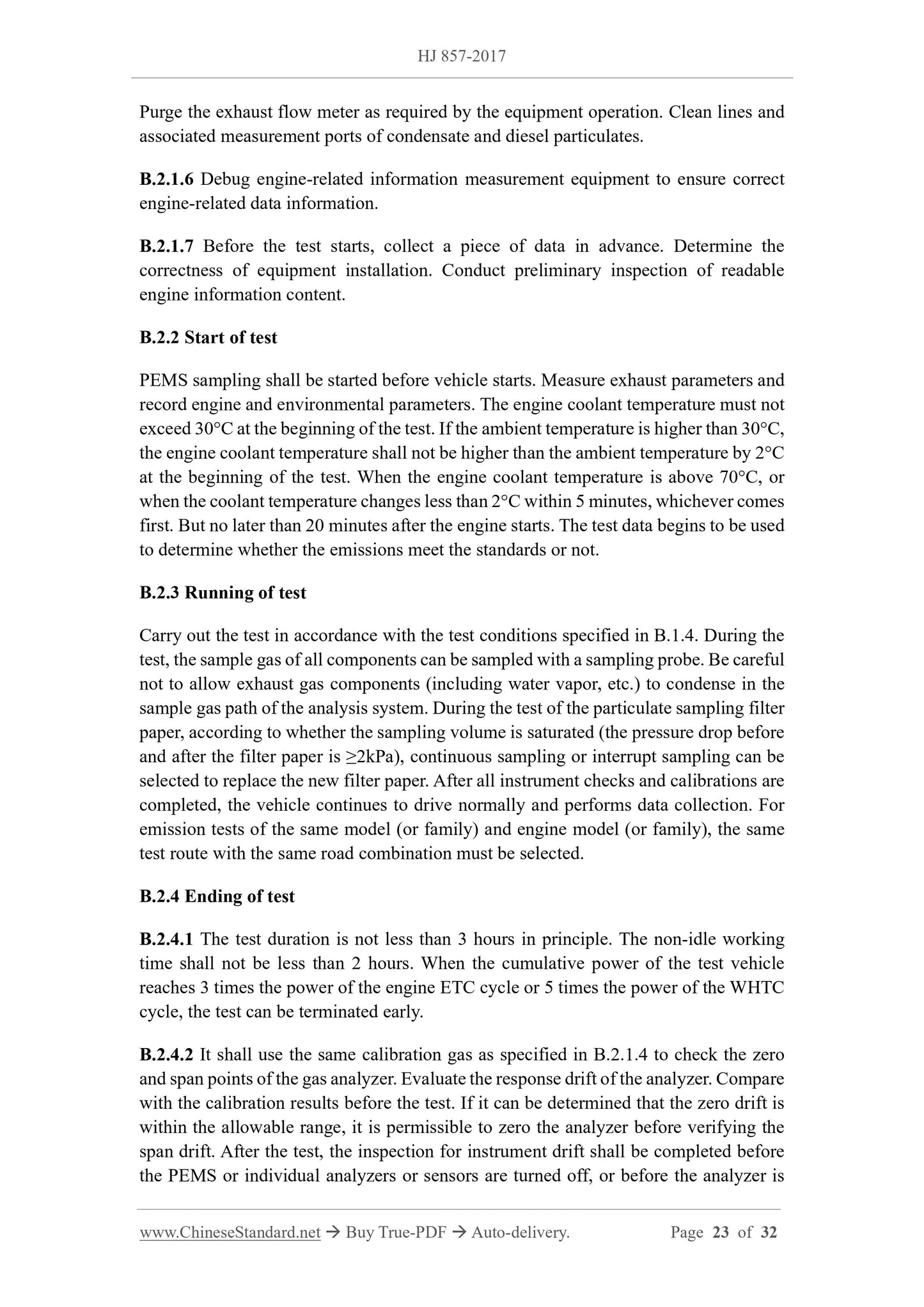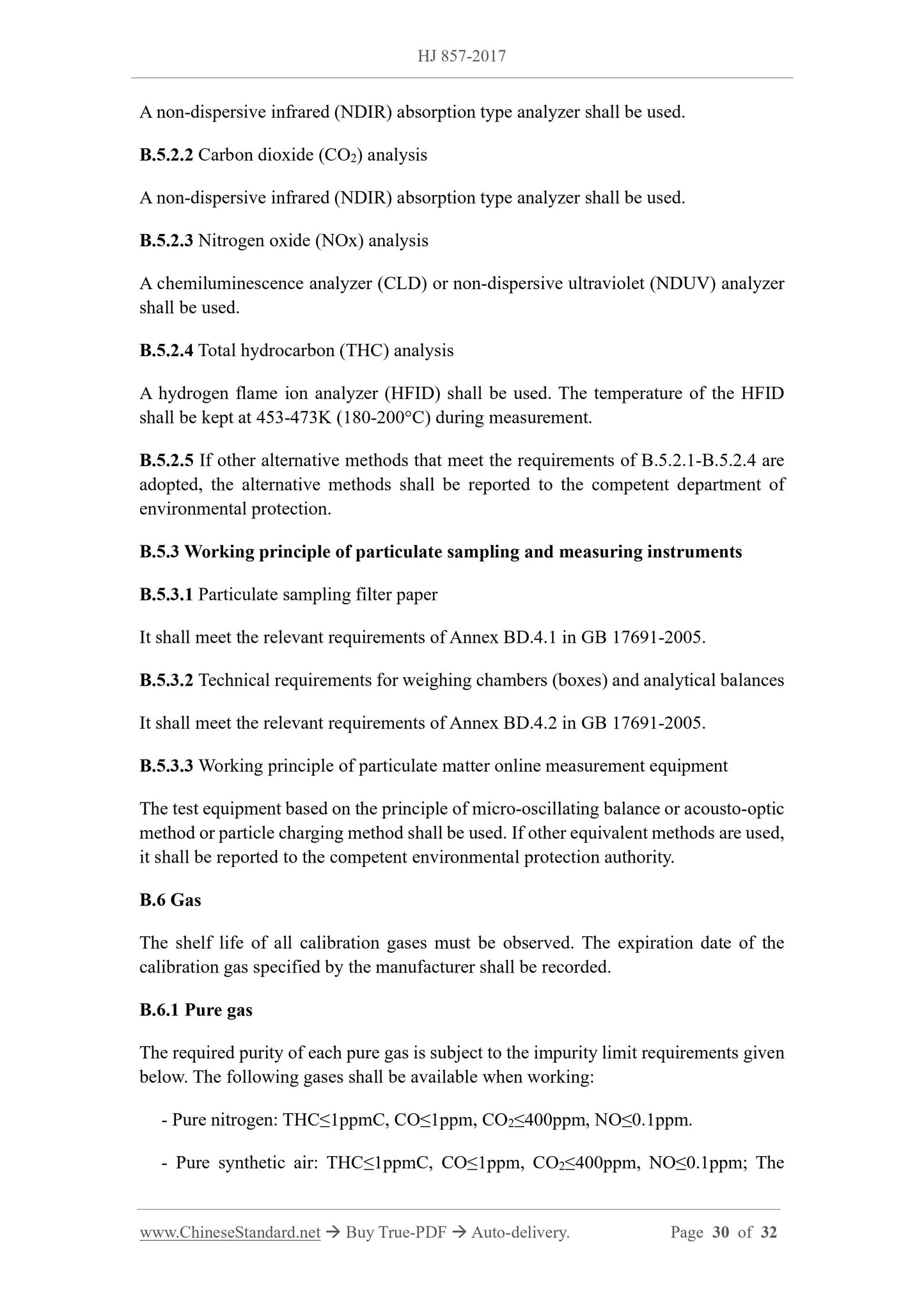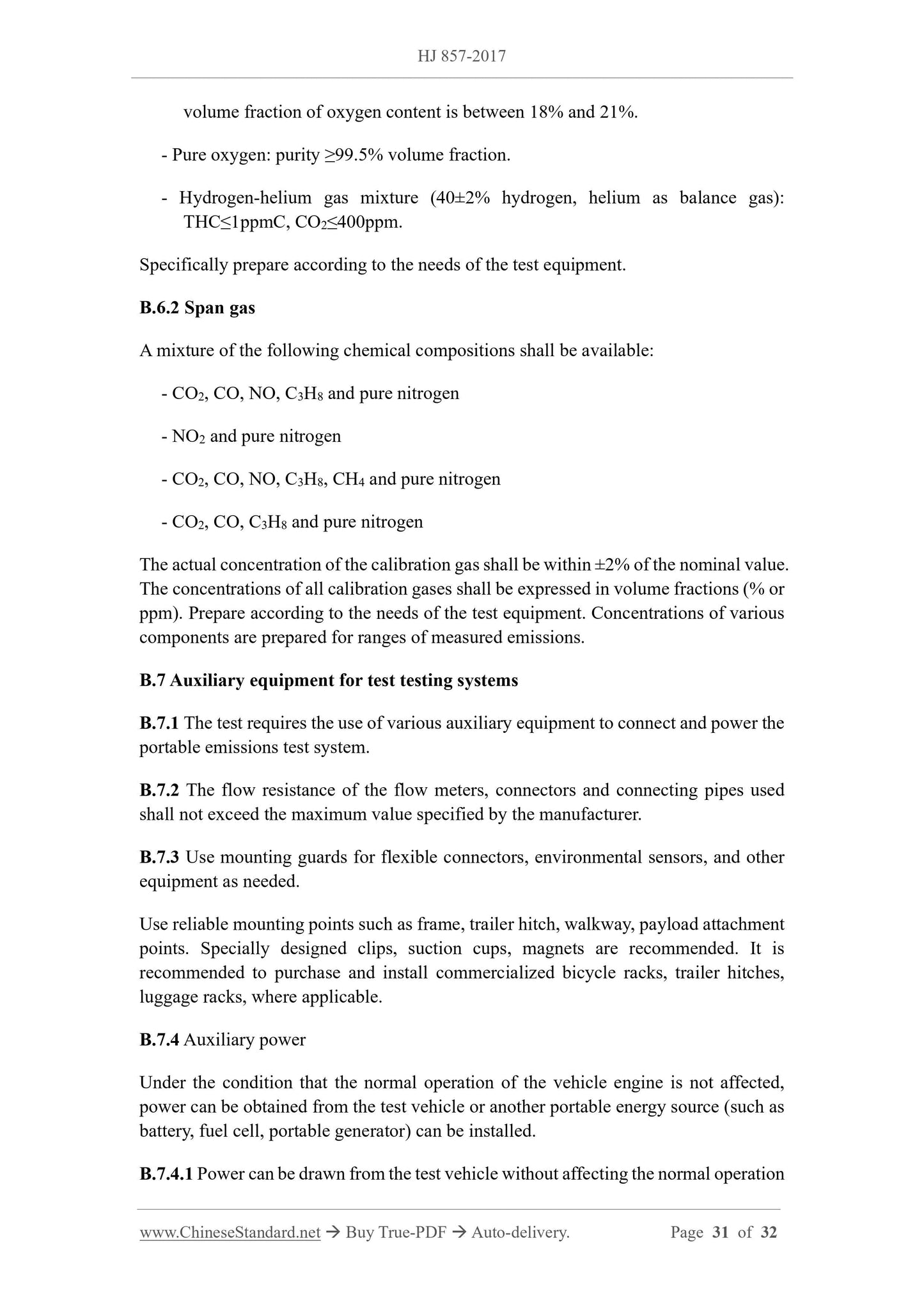1
/
of
10
www.ChineseStandard.us -- Field Test Asia Pte. Ltd.
HJ 857-2017 English PDF
HJ 857-2017 English PDF
Regular price
$340.00
Regular price
Sale price
$340.00
Unit price
/
per
Shipping calculated at checkout.
Couldn't load pickup availability
HJ 857-2017: Measurement method and technical specification for PEMS test of exhaust pollutants from heavy-duty diesel and gas fuelled vehicles
Delivery: 9 seconds. Download (& Email) true-PDF + Invoice.
Get Quotation: Click HJ 857-2017 (Self-service in 1-minute)
Historical versions (Master-website): HJ 857-2017
Preview True-PDF (Reload/Scroll-down if blank)
HJ 857-2017
NATIONAL ENVIRONMENTAL PROTECTION STANDARD
OF THE PEOPLE’S REPUBLIC OF CHINA
Measurement method and technical specification for PEMS
test of exhaust pollutants from heavy-duty diesel and gas
fuelled vehicles
ISSUED ON: SEPTEMBER 19, 2017
IMPLEMENTED ON: OCTOBER 01, 2017
Issued by: Ministry of Environmental Protection of PRC
Table of Contents
Foreword ... 3
1 Scope of application ... 4
2 Normative references ... 4
3 Terms and definitions... 5
4 Technical requirements and tests ... 6
5 Emission compliance inspection of new production vehicles and in-use compliance
inspection ... 7
6 Implementation of the standard ... 9
Annex A (normative) Vehicle emission test report requirements ... 10
Annex B (normative) PEMS measurement method for actual road emissions of heavy-
duty vehicles ... 17
Measurement method and technical specification for PEMS
test of exhaust pollutants from heavy-duty diesel and gas
fuelled vehicles
1 Scope of application
This Standard specifies PEMS measurement method and technical specification for
exhaust pollutants from heavy-duty diesel and gas fuelled vehicles. It is applicable to
emission compliance inspection and in-use compliance inspection of new production
vehicles of heavy-duty diesel vehicles and gas-fueled vehicles that meet stage 5 of GB
17691-2005.
This Standard is applicable to measurement of exhaust pollutants from M2, M3, N2 (but
excluding low-speed goods vehicles) and N3 vehicles that are equipped with
compression ignition, gas fuel ignition engines with a design speed of more than
25km/h, as well as M1 vehicles that a total mass is greater than 3500kg.
2 Normative references
The provisions in following documents become the provisions of this Standard through
reference in this Standard. For undated references, the latest edition of the referenced
document applies.
GB/T 12534, Motor vehicles - General rules of road test method
GB/T 15089-2001, Classification of power-driven vehicles and trailers
GB 17691-2005, Limits and measurement methods for exhaust pollutants from
compression ignition and gas fuelled positive ignition engines of vehicles (III IV V)
GB 18352.6-2016, Limits and measurement methods for emissions from light-duty
vehicles (CHINA 6)
HJ 437-2008, Technical specification for on-board diagnostic (OBD)system of
compression ignition and gas fuelled positive ignition engines of vehicles
HJ 438-2008, Durability of Emission Control Systems of Compression Ignition and
Gas Fuelled Positive Ignition Engines of Vehicles
HJ 689-2014, Limits and Measurement Methods for Exhaust Pollutants from Diesel
Engines of Urban Vehicles (WHTC)
3 Terms and definitions
For the purposes of this document, the terms and definitions defined in GB 17691-2005
and HJ 689-2014 as well as the followings apply.
3.1 portable emissions measurement system PEMS
a complete set of emission testing systems, that can be installed in the vehicle, that can
simultaneously measure exhaust flow, pollutant concentration, ambient temperature,
humidity, atmospheric pressure, and that can conduct real-time measurement or
collection of related parameters such as engine speed, torque, load, vehicle speed,
latitude, longitude, and altitude.
3.2 PEMS method
a method that installs the portable emission measurement system on the testing vehicle,
so as to measure the exhaust pollutant emissions when the vehicle is driving on the
actual road.
3.3 transient cycle
the transient cycle (ETC or WHTC) used when type inspection is carried out for the
engine according to GB 17691-2005 or HJ 689-2014.
3.4 work-based window
a continuous interval from the trial termination point to the cutoff point; when the
cumulative work in the interval is equal to the engine work in the transient cycle, the
continuous interval is defined as a work-based window.
3.5 window brake-specific emissions
the ratio of the total mass of vehicle exhaust pollutants emitted in the work-based
window to the amount of work done in the window, in g/kWh.
3.6 work-based window method
a method that evaluates vehicle emissions by comparing the compliance of specific
emissions of various work-based windows with those of engine type inspection specific
emissions.
3.7 average window power percentage
the percentage that the average power of the engine in the work-based window accounts
for the maximum net power of the engine.
3.8 valid work-based window
4.3.2 Determination of test vehicle compliance
a) For any pollutant specified in Article 4.1.1, if the proportion of the work-based
window that meets the emission limit requirements accounts for 90% or more of
the valid work-based window, the test vehicle will be judged as meeting the
emission standards. Otherwise, it is determined that the emission exceeds the
standard.
b) Among the valid data points, the data points whose NOx emission concentration
meets the limit requirements of Article 4.1.2 account for 95% or more of the valid
data points, then the test vehicle is determined to meet the emission standards.
Otherwise, it is determined that the emission exceeds the standard.
5 Emission compliance inspection of new production vehicles
and in-use compliance inspection
5.1 Emission compliance inspection of new production vehicles
5.1.1 The manufacturer shall formulate scientific and efficient self-inspection
procedures in accordance with the requirements of this Standard. Conduct self-
inspection on emission compliance of newly produced models (or series). Report the
results of the self-inspection to the competent environmental protection authority.
5.1.2 When the environmental protection authority conducts the inspection of the new
production vehicle emission standards on the model (or series), 3 vehicles are randomly
selected from the mass-produced vehicles. Determine according to the following rules:
a) Randomly select 1 vehicle from the 3 vehicles that are drawn in Article 5.1.2.
Carry out the actual road emission test according to the method specified in
Annex B. If the vehicle meets the requirements of Article 4.1, it is determined as
conforming.
b) If the vehicle does not meet the requirements of Article 4.1, if the manufacturer
submits a written application, the environmental protection authority shall
conduct the actual road emission test according to the method specified in Annex
B for the other two vehicles selected in Article 5.1.2. If both vehicles meet the
requirements of Article 4.1, it is determined to be conforming, otherwise it is not
conforming.
5.2 In-use compliance inspection
5.2.1 The manufacturer shall conduct self-inspection of in-use compliance according to
the test methods specified in this Standard. The in-use compliance self-inspection of
the engine manufacturer shall be carried out on the basis of the engine model (or family).
The in-use compliance self-inspection of vehicle manufacturers shall be carried out on
- Dry base CO concentration, %;
- Hydrogen molar ratio.
B.1.4 Test conditions
B.1.4.1 The composition of test conditions shall be close to the distribution of road
operating conditions when the vehicle is in normal use. Vehicle operating road
conditions include urban roads, suburban roads and expressways. According to the
vehicle category, the specific distribution and characteristics refer to the provisions of
B.1.4.2-B.1.4.6. The actual composition ratio is allowed to have a deviation of ±5%.
Due to some practical reasons, manufacturer can also adjust the test conditions
according to the actual situation. However, the relevant situation shall be reported to
the competent department of environmental protection.
B.1.4.2 The test shall be carried out continuously in the order of urban-suburban-high-
speed driving. According to the size of the vehicle's driving speed, distinguish the
attributes of the vehicle's running road. Urban road: the vehicle speed is between 0-
50km/h, and the average speed is 15-30km/h. Suburban road: the first short trip with a
vehicle speed exceeding 55km/h is recorded as the beginning of the suburban road, the
vehicle speed is not more than 75km/h, and the average speed is 45-70km/h.
Expressway: the first short trip with a vehicle speed exceeding 75km/h is recorded as
the beginning of the expressway, and the average vehicle speed is greater than 70km/h.
B.1.4.3 For M1, M2, M3, and N2 vehicles (except urban vehicles), the time allocation
ratio of each operating road condition during the test is 20% of urban roads, 25% of
suburban roads and 55% of expressways.
B.1.4.4 For urban vehicles, the time allocation ratio of each operating road condition
during the test is 70% of urban roads and 30% of suburban roads.
B.1.4.5 For N3 vehicles (except postal and sanitation vehicles), the time allocation ratio
of each operating road condition during the test is 10% of urban roads, 10% of suburban
roads and 80% of expressways.
B.1.4.6 The difference in altitude between the start and end points of the test shall not
exceed 100m. The cumulative positive altitude increment of the test vehicle shall not
be greater than 1200m/100km. The calculation method of cumulative altitude refers to
the provisions of Annex DH of GB 18352.6-2016.
B.1.5 Device installation connection
B.1.5.1 Main unit
Install the PEMS on the test vehicle as required by the operation. The installation
location is least affected by the following external conditions:
- Changes in ambient temperature;
- Changes in ambient atmospheric pressure;
- Electromagnetic radiation;
- Mechanical vibration;
- Hydrocarbons in the environment (if the hydrogen flame ionization detector (HFID)
combustion gas is ambient air).
B.1.5.2 Exhaust flow meter (EFM)
The exhaust flow meter shall be connected to the exhaust pipe of the test vehicle. It can
be connected using short flexible connectors when needed. However, flexible
connectors need to be sealed with stainless steel hose clamps or clips. The contact area
between the exhaust gas and the flexible connector shall be minimized, so as to avoid
affecting the test results at high vehicle speeds and under heavy engine load conditions.
The straight pipe length upstream and downstream of the location of the exhaust gas
flow meter sensor shall be at least twice the diameter of the exhaust gas flow meter. It
is recommended to install the exhaust flow meter behind the vehicle muffler, so as to
reduce the influence of transient changes in the exhaust flow on the measurement signal.
The exhaust flow meter must not be installed such that the exhaust back pressure is
greater than the engine manufacturer's recommendation. It is also not possible to
increase the length of the exhaust pipe by more than 2.5m. The installation of the
exhaust flow meter shall comply with local road traffic safety regulations and insurance
requirements.
B.1.5.3 Satellite navigation precision positioning system
The signal receiving device shall be installed as high as possible. At the same time,
avoid the interference of all obstacles during the test.
B.1.5.4 ECU data reading device
The ECU data reading equipment shall be able to record the engine parameters listed in
Table B.1 in real time. It can obtain the ECU data of the test vehicle according to
standard protocols such as SAE J1939, J1708 or ISO 15031.
B.1.5.5 Sampling system
The sampling probe shall be installed in accordance with the installation regulations
specified by the instrument manufacturer. It is installed after the flow measuring device.
The gaseous pollutant heating sampling line (the heating temperature is 190℃±10℃,
if applicable) shall be insulated at the connection point between the sampling probe and
Purge the exhaust flow meter as required by the equipment operation. Clean lines and
associated measurement ports of condensate and diesel particulates.
B.2.1.6 Debug engine-related information measurement equipment to ensure correct
engine-related data information.
B.2.1.7 Before the test starts, collect a piece of data in advance. Determine the
correctness of equipment installation. Conduct preliminary inspection of readable
engine information content.
B.2.2 Start of test
PEMS sampling shall be started before vehicle starts. Measure exhaust parameters and
record engine and environmental parameters. The engine coolant temperature must not
exceed 30°C at the beginning of the test. If the ambient temperature is higher than 30°C,
the engine coolant temperature shall not be higher than the ambient temperature by 2°C
at the beginning of the test. When the engine coolant temperature is above 70°C, or
when the coolant temperature changes less than 2°C within 5 minutes, whichever comes
first. But no later than 20 minutes after the engine starts. The test data begins to be used
to determine whether the emissions meet the standards or not.
B.2.3 Running of test
Carry out the test in accordance with the test conditions specified in B.1.4. During the
test, the sample gas of all components can be sampled with a sampling probe. Be careful
not to allow exhaust gas components (including water vapor, etc.) to condense in the
sample gas path of the analysis system. During the test of the particulate sampling filter
paper, according to whether the sampling volume is saturated (the pressure drop before
and after the filter paper is ≥2kPa), continuous sampling or interrupt sampling can be
selected to replace the new filter paper. After all instrument checks and calibrations are
completed, the vehicle continues to drive normally and performs data collection. For
emission tests of the same model (or family) and engine model (or family), the same
test route with the same road combination must be selected.
B.2.4 Ending of test
B.2.4.1 The test duration is not less than 3 hours in principle. The non-idle working
time shall not be less than 2 hours. When the cumulative power of the test vehicle
reaches 3 times the power of the engine ETC cycle or 5 times the power of the WHTC
cycle, the test can be termina...
Delivery: 9 seconds. Download (& Email) true-PDF + Invoice.
Get Quotation: Click HJ 857-2017 (Self-service in 1-minute)
Historical versions (Master-website): HJ 857-2017
Preview True-PDF (Reload/Scroll-down if blank)
HJ 857-2017
NATIONAL ENVIRONMENTAL PROTECTION STANDARD
OF THE PEOPLE’S REPUBLIC OF CHINA
Measurement method and technical specification for PEMS
test of exhaust pollutants from heavy-duty diesel and gas
fuelled vehicles
ISSUED ON: SEPTEMBER 19, 2017
IMPLEMENTED ON: OCTOBER 01, 2017
Issued by: Ministry of Environmental Protection of PRC
Table of Contents
Foreword ... 3
1 Scope of application ... 4
2 Normative references ... 4
3 Terms and definitions... 5
4 Technical requirements and tests ... 6
5 Emission compliance inspection of new production vehicles and in-use compliance
inspection ... 7
6 Implementation of the standard ... 9
Annex A (normative) Vehicle emission test report requirements ... 10
Annex B (normative) PEMS measurement method for actual road emissions of heavy-
duty vehicles ... 17
Measurement method and technical specification for PEMS
test of exhaust pollutants from heavy-duty diesel and gas
fuelled vehicles
1 Scope of application
This Standard specifies PEMS measurement method and technical specification for
exhaust pollutants from heavy-duty diesel and gas fuelled vehicles. It is applicable to
emission compliance inspection and in-use compliance inspection of new production
vehicles of heavy-duty diesel vehicles and gas-fueled vehicles that meet stage 5 of GB
17691-2005.
This Standard is applicable to measurement of exhaust pollutants from M2, M3, N2 (but
excluding low-speed goods vehicles) and N3 vehicles that are equipped with
compression ignition, gas fuel ignition engines with a design speed of more than
25km/h, as well as M1 vehicles that a total mass is greater than 3500kg.
2 Normative references
The provisions in following documents become the provisions of this Standard through
reference in this Standard. For undated references, the latest edition of the referenced
document applies.
GB/T 12534, Motor vehicles - General rules of road test method
GB/T 15089-2001, Classification of power-driven vehicles and trailers
GB 17691-2005, Limits and measurement methods for exhaust pollutants from
compression ignition and gas fuelled positive ignition engines of vehicles (III IV V)
GB 18352.6-2016, Limits and measurement methods for emissions from light-duty
vehicles (CHINA 6)
HJ 437-2008, Technical specification for on-board diagnostic (OBD)system of
compression ignition and gas fuelled positive ignition engines of vehicles
HJ 438-2008, Durability of Emission Control Systems of Compression Ignition and
Gas Fuelled Positive Ignition Engines of Vehicles
HJ 689-2014, Limits and Measurement Methods for Exhaust Pollutants from Diesel
Engines of Urban Vehicles (WHTC)
3 Terms and definitions
For the purposes of this document, the terms and definitions defined in GB 17691-2005
and HJ 689-2014 as well as the followings apply.
3.1 portable emissions measurement system PEMS
a complete set of emission testing systems, that can be installed in the vehicle, that can
simultaneously measure exhaust flow, pollutant concentration, ambient temperature,
humidity, atmospheric pressure, and that can conduct real-time measurement or
collection of related parameters such as engine speed, torque, load, vehicle speed,
latitude, longitude, and altitude.
3.2 PEMS method
a method that installs the portable emission measurement system on the testing vehicle,
so as to measure the exhaust pollutant emissions when the vehicle is driving on the
actual road.
3.3 transient cycle
the transient cycle (ETC or WHTC) used when type inspection is carried out for the
engine according to GB 17691-2005 or HJ 689-2014.
3.4 work-based window
a continuous interval from the trial termination point to the cutoff point; when the
cumulative work in the interval is equal to the engine work in the transient cycle, the
continuous interval is defined as a work-based window.
3.5 window brake-specific emissions
the ratio of the total mass of vehicle exhaust pollutants emitted in the work-based
window to the amount of work done in the window, in g/kWh.
3.6 work-based window method
a method that evaluates vehicle emissions by comparing the compliance of specific
emissions of various work-based windows with those of engine type inspection specific
emissions.
3.7 average window power percentage
the percentage that the average power of the engine in the work-based window accounts
for the maximum net power of the engine.
3.8 valid work-based window
4.3.2 Determination of test vehicle compliance
a) For any pollutant specified in Article 4.1.1, if the proportion of the work-based
window that meets the emission limit requirements accounts for 90% or more of
the valid work-based window, the test vehicle will be judged as meeting the
emission standards. Otherwise, it is determined that the emission exceeds the
standard.
b) Among the valid data points, the data points whose NOx emission concentration
meets the limit requirements of Article 4.1.2 account for 95% or more of the valid
data points, then the test vehicle is determined to meet the emission standards.
Otherwise, it is determined that the emission exceeds the standard.
5 Emission compliance inspection of new production vehicles
and in-use compliance inspection
5.1 Emission compliance inspection of new production vehicles
5.1.1 The manufacturer shall formulate scientific and efficient self-inspection
procedures in accordance with the requirements of this Standard. Conduct self-
inspection on emission compliance of newly produced models (or series). Report the
results of the self-inspection to the competent environmental protection authority.
5.1.2 When the environmental protection authority conducts the inspection of the new
production vehicle emission standards on the model (or series), 3 vehicles are randomly
selected from the mass-produced vehicles. Determine according to the following rules:
a) Randomly select 1 vehicle from the 3 vehicles that are drawn in Article 5.1.2.
Carry out the actual road emission test according to the method specified in
Annex B. If the vehicle meets the requirements of Article 4.1, it is determined as
conforming.
b) If the vehicle does not meet the requirements of Article 4.1, if the manufacturer
submits a written application, the environmental protection authority shall
conduct the actual road emission test according to the method specified in Annex
B for the other two vehicles selected in Article 5.1.2. If both vehicles meet the
requirements of Article 4.1, it is determined to be conforming, otherwise it is not
conforming.
5.2 In-use compliance inspection
5.2.1 The manufacturer shall conduct self-inspection of in-use compliance according to
the test methods specified in this Standard. The in-use compliance self-inspection of
the engine manufacturer shall be carried out on the basis of the engine model (or family).
The in-use compliance self-inspection of vehicle manufacturers shall be carried out on
- Dry base CO concentration, %;
- Hydrogen molar ratio.
B.1.4 Test conditions
B.1.4.1 The composition of test conditions shall be close to the distribution of road
operating conditions when the vehicle is in normal use. Vehicle operating road
conditions include urban roads, suburban roads and expressways. According to the
vehicle category, the specific distribution and characteristics refer to the provisions of
B.1.4.2-B.1.4.6. The actual composition ratio is allowed to have a deviation of ±5%.
Due to some practical reasons, manufacturer can also adjust the test conditions
according to the actual situation. However, the relevant situation shall be reported to
the competent department of environmental protection.
B.1.4.2 The test shall be carried out continuously in the order of urban-suburban-high-
speed driving. According to the size of the vehicle's driving speed, distinguish the
attributes of the vehicle's running road. Urban road: the vehicle speed is between 0-
50km/h, and the average speed is 15-30km/h. Suburban road: the first short trip with a
vehicle speed exceeding 55km/h is recorded as the beginning of the suburban road, the
vehicle speed is not more than 75km/h, and the average speed is 45-70km/h.
Expressway: the first short trip with a vehicle speed exceeding 75km/h is recorded as
the beginning of the expressway, and the average vehicle speed is greater than 70km/h.
B.1.4.3 For M1, M2, M3, and N2 vehicles (except urban vehicles), the time allocation
ratio of each operating road condition during the test is 20% of urban roads, 25% of
suburban roads and 55% of expressways.
B.1.4.4 For urban vehicles, the time allocation ratio of each operating road condition
during the test is 70% of urban roads and 30% of suburban roads.
B.1.4.5 For N3 vehicles (except postal and sanitation vehicles), the time allocation ratio
of each operating road condition during the test is 10% of urban roads, 10% of suburban
roads and 80% of expressways.
B.1.4.6 The difference in altitude between the start and end points of the test shall not
exceed 100m. The cumulative positive altitude increment of the test vehicle shall not
be greater than 1200m/100km. The calculation method of cumulative altitude refers to
the provisions of Annex DH of GB 18352.6-2016.
B.1.5 Device installation connection
B.1.5.1 Main unit
Install the PEMS on the test vehicle as required by the operation. The installation
location is least affected by the following external conditions:
- Changes in ambient temperature;
- Changes in ambient atmospheric pressure;
- Electromagnetic radiation;
- Mechanical vibration;
- Hydrocarbons in the environment (if the hydrogen flame ionization detector (HFID)
combustion gas is ambient air).
B.1.5.2 Exhaust flow meter (EFM)
The exhaust flow meter shall be connected to the exhaust pipe of the test vehicle. It can
be connected using short flexible connectors when needed. However, flexible
connectors need to be sealed with stainless steel hose clamps or clips. The contact area
between the exhaust gas and the flexible connector shall be minimized, so as to avoid
affecting the test results at high vehicle speeds and under heavy engine load conditions.
The straight pipe length upstream and downstream of the location of the exhaust gas
flow meter sensor shall be at least twice the diameter of the exhaust gas flow meter. It
is recommended to install the exhaust flow meter behind the vehicle muffler, so as to
reduce the influence of transient changes in the exhaust flow on the measurement signal.
The exhaust flow meter must not be installed such that the exhaust back pressure is
greater than the engine manufacturer's recommendation. It is also not possible to
increase the length of the exhaust pipe by more than 2.5m. The installation of the
exhaust flow meter shall comply with local road traffic safety regulations and insurance
requirements.
B.1.5.3 Satellite navigation precision positioning system
The signal receiving device shall be installed as high as possible. At the same time,
avoid the interference of all obstacles during the test.
B.1.5.4 ECU data reading device
The ECU data reading equipment shall be able to record the engine parameters listed in
Table B.1 in real time. It can obtain the ECU data of the test vehicle according to
standard protocols such as SAE J1939, J1708 or ISO 15031.
B.1.5.5 Sampling system
The sampling probe shall be installed in accordance with the installation regulations
specified by the instrument manufacturer. It is installed after the flow measuring device.
The gaseous pollutant heating sampling line (the heating temperature is 190℃±10℃,
if applicable) shall be insulated at the connection point between the sampling probe and
Purge the exhaust flow meter as required by the equipment operation. Clean lines and
associated measurement ports of condensate and diesel particulates.
B.2.1.6 Debug engine-related information measurement equipment to ensure correct
engine-related data information.
B.2.1.7 Before the test starts, collect a piece of data in advance. Determine the
correctness of equipment installation. Conduct preliminary inspection of readable
engine information content.
B.2.2 Start of test
PEMS sampling shall be started before vehicle starts. Measure exhaust parameters and
record engine and environmental parameters. The engine coolant temperature must not
exceed 30°C at the beginning of the test. If the ambient temperature is higher than 30°C,
the engine coolant temperature shall not be higher than the ambient temperature by 2°C
at the beginning of the test. When the engine coolant temperature is above 70°C, or
when the coolant temperature changes less than 2°C within 5 minutes, whichever comes
first. But no later than 20 minutes after the engine starts. The test data begins to be used
to determine whether the emissions meet the standards or not.
B.2.3 Running of test
Carry out the test in accordance with the test conditions specified in B.1.4. During the
test, the sample gas of all components can be sampled with a sampling probe. Be careful
not to allow exhaust gas components (including water vapor, etc.) to condense in the
sample gas path of the analysis system. During the test of the particulate sampling filter
paper, according to whether the sampling volume is saturated (the pressure drop before
and after the filter paper is ≥2kPa), continuous sampling or interrupt sampling can be
selected to replace the new filter paper. After all instrument checks and calibrations are
completed, the vehicle continues to drive normally and performs data collection. For
emission tests of the same model (or family) and engine model (or family), the same
test route with the same road combination must be selected.
B.2.4 Ending of test
B.2.4.1 The test duration is not less than 3 hours in principle. The non-idle working
time shall not be less than 2 hours. When the cumulative power of the test vehicle
reaches 3 times the power of the engine ETC cycle or 5 times the power of the WHTC
cycle, the test can be termina...
Share
